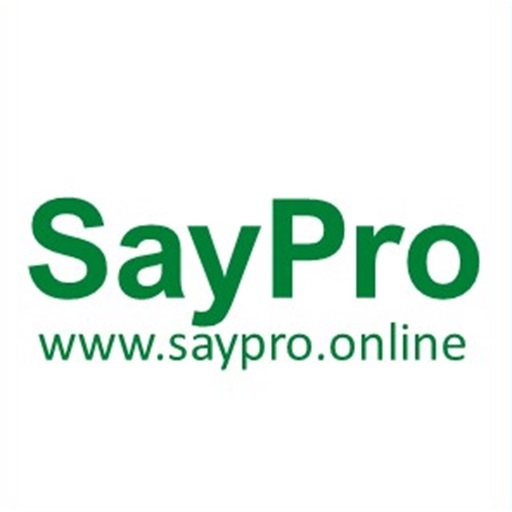Your cart is currently empty!
SayPro Generate a variety of workplace reports using various data gathering techniques
Report WritingWhat is the Basic Structure of a Report?Types of reports can vary greatly; they can range from an experimental report to an environmental impact statement. There is however, a basic structure common to most reports, irrespective of their type.The Major Components of a General Report: what was the problem, how was it investigated, what did you find out and what do your findings mean?A list of the major and minor sections of your report. Set the scene; give some background information about the topic. State the aim/purpose of the investigation. Outline the body sections.Organise the sections in a logical sequence: what you investigated, what you found, what interpretations and what judgements you made. Use short informative headings and subheadings. What has been achieved and what is the significance of your findings and your discussion? Have your aims been successful or not?What do you recommend as a course of action following your conclusion?A list of all the sources you used. Any information (graphs, charts, tables or other data) you used in your report but did not include in the body.Writing Your ReportThis section deals with the next step, writing the important sections of your report: the introduction, conclusion and abstract. They are important because most readers will focus on these sections.Abstracts, Introductions & Conclusions—what’s the difference?An abstract is a brief statement which outlines the report in full; what was done, achieved, decided and concluded. The introduction is a section which states your aims and some required background knowledge. An introduction will also outline the body of the report (where you state what you will do). Don’t confuse the introduction with the abstract or summary; they are NOT the same. The common misconception is that one is simply a smaller version of the other (that the introduction is a rewritten, chopped-up version of the abstract). However, this is not the case.The AbstractMost reports need an abstract, but they are generally more important for technical reports or scientific documents.• An abstract is a succinct passage which provides a brief outline on what was achieved/decided/concluded in your report.• An abstract is placed on a separate page before the contents page.• An abstract can be written last so that every bit of necessary detail is taken from the finished report.• An abstract is one part of a report that will certainly be read by a client/assessor/manager. The rest of the report is read if more detail is required.• An abstract is about half a page in length. Sometimes a word limit is given. This can range from 50-300 words.The IntroductionThe aim of an introduction is to state what you have been asked to achieve and list your current course of action.The ConclusionThe conclusion (along with the introduction and abstract) is generally the section most read by clients. If you can conclude your work /findings well, you facilitate your client’s understanding of your work’s significance, your achievements and whether your aims have been successful or not. Even in the face of failure, e.g. your experiments do not work, a proper conclusion would demonstrate an understanding of what you achieved. Here is how to do that:• Note the shortcomings and pitfalls of the methods and/or equipment used• State your findings from the analysis of your data• Outline possible recommendations (e.g. provide suggestions for further research).Recommendations may form a separate heading if substantial.Note: Do not use your abstract to write your conclusion or vice versa as the reader will believe you have not put enough thought into why you are doing your work. Remember the abstract, introduction and conclusions have different purposes, different emphasis and different structures.
 |
Rebecca Maapola | SayPro Administration ManagerSayProWebsite: www.saypro.onlineCell: 27 (0) 71 240 2557Email: rebeccaStudy and Qualifications www.saypro.online Our Company www.saypro.online |
SayPro is a group of brands leading in Africa’s development, building innovative online solutions and a strategic institution on child growth, youth empowerment and adult support programmes, applications in Africa.SayPro Core Skills and Expertise:
- SayPro Artificial Intelligence, Graphics, Online Design and Web Development
- SayPro Higher Education, Certification, ELearning Development, Qualification Design and Online Training.
- SayPro Community Development in Youth Unemployment, HIV/AIDS, Human Rights and Gender-Based Violence
- SayPro Company Registrations, Tax, VAT and Website Designs.
- SayPro Research, Opportunity Sharing in Tenders, Funding and Contact Directories.
- SayPro Monitoring, Evaluation, Knowledge Management, Learning and Sharing.
SayPro is providing international and global opportunities for African youth. Partner with SayPro now by sending an email to info or give us a call at + 27 11 071 1903Please visit our website at www.saypro.online Email: info@saypro.online Email: info@saypro.online Call: + 27 11 071 1903 WhatsApp: + 27 84 313 7407. Comment below for any questions and feedback. For SayPro Courses, SayPro Jobs, SayPro Community Development, SayPro Products, SayPro Services, SayPro Consulting, and SayPro Advisory visit our website to www.saypro.onlinePlease visit our website at www.saypro.online Email: info@saypro.online Email: info@saypro.online Call: + 27 11 071 1903 WhatsApp: + 27 84 313 7407. Comment below for any questions and feedback. For SayPro Courses, SayPro Jobs, SayPro Community Development, SayPro Products, SayPro Services, SayPro Consulting, and SayPro Advisory visit our website to www.saypro.online

Leave a Reply
You must be logged in to post a comment.